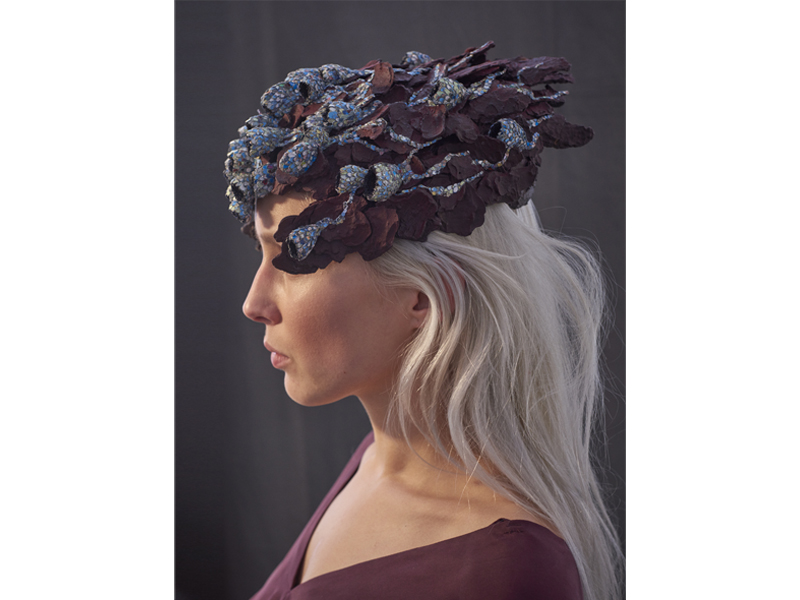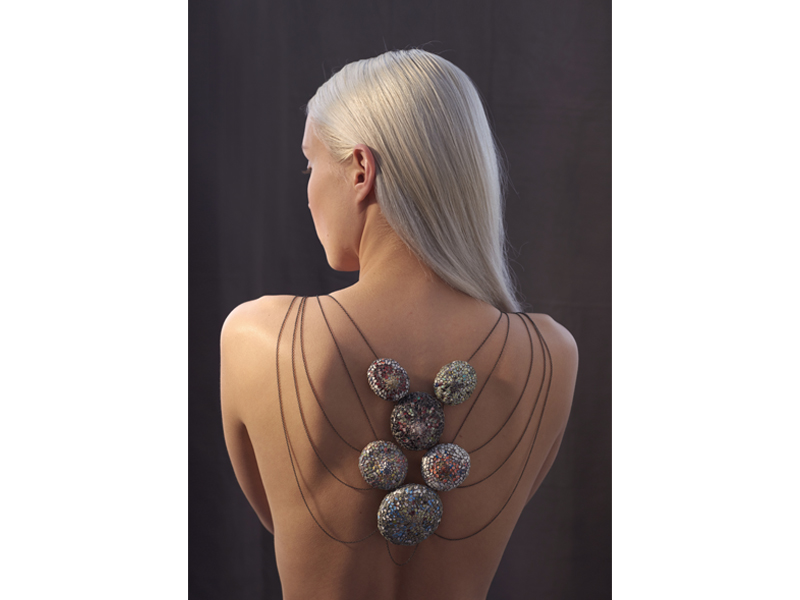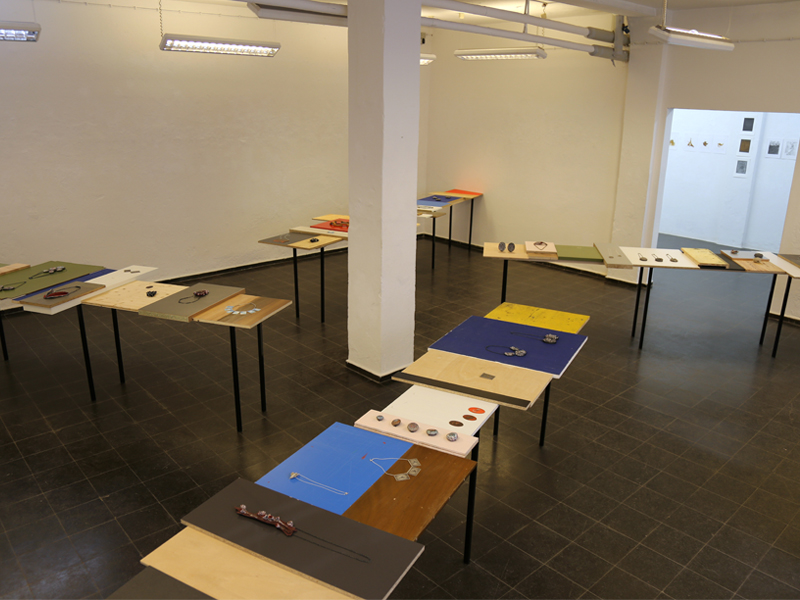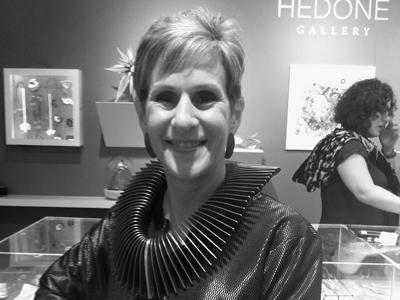
I had the pleasure of interviewing Carina Shoshtary a year ago as one of the finalists for the AJF Artist Award. Fast forward a year and here we are again, this time with her as a finalist for the new Susan Beech Mid-Career Grant. It’s easy to see why Carina is the only maker to have achieved this distinction. Her jewelry is imaginative, innovative, and emotional, using unusual materials such as graffiti, old bobbin laces, and pieces of plastic netting, transforming them into ethereal pieces of jewelry. Carina took time out of her busy schedule to talk about her project proposal for the Mid-Career Grant and other projects she’s working on.
Bonnie Levine: First and foremost, many congratulations on being named a finalist for the 2017 Susan Beech Mid-Career Grant! It’s quite an accomplishment, given the large number of proposals that were received. And it’s even more of an accomplishment because you were also selected as a finalist for the 2016 AJF Artist Award just a year ago. How does it feel to be a finalist in two such important competitions?
Carina Shoshtary: Thank you! It’s an honor to have been selected for both competitions as a finalist. 2016 was the last year I could apply for the AJF Artist Award because now I’m too old for it. Most competitions for young/emerging artists have an age limit of 35. And I do feel I’m entering a new phase with my art and my career now. I’ve made art jewelry for 11 years (jewelry for 16 years), and it feels good not to be a newcomer anymore. When I received the email with info about the Susan Beech Mid-Career Grant, my first reaction was that it was too early for me to apply for it and maybe I didn’t have enough experience. But then my head started spinning around these fragmentary ideas I had had for a while, until they became concrete enough to start writing them down. In retrospect I feel that this call for project proposals was an excellent opportunity to dare to dream and think big and to shape a vision of what else I would like to implement in the future.

Your proposal for the Mid-Career Grant was called The Hunter—a project including art jewelry, music, and video. Tell us about the project and how these three art forms interact to tell a story. What was the inspiration behind your idea?
Carina Shoshtary: For a year and a half now, I’ve been working on a body of work I call The Hunter. In my imagination, I picture what kind of jewelry a fictitious tribe of hunter-gatherers would wear to mediate strength or fertility, or what their ceremonial jewelry would look like. The idea came up because I normally collect my materials in my immediate surroundings. The idea of “the hunter” has a symbolic meaning for me. I believe we are all hunting for something, consciously or subconsciously, and it is the main subject of our deepest longing, which often directs our actions.
When I was looking for words to describe the emotional and psychological part of The Hunter, I spontaneously wrote and recorded the sketch of a song instead. It came much easier to me. I find music, more than any other art form, has this amazing power to transport emotions directly and effortlessly. I know, though, where my boundaries are. Before I would use the song as part of an exhibition alongside my jewelry or publish it in any other way, I would like to collaborate with professional musicians to upgrade the sketch into a well-mixed song with substance and structure. For my Susan Beech Grant project proposal I took it one step further. I wondered how the jewelry and the song could best interact together in an exhibition space, and immediately thought of an artistic music video which would take on the hunter theme. I picture film stills or slow-motion scenes, e.g., showing a member of the tribe performing one of their rituals. As I have no knowledge about video making or cutting, I would like to collaborate with someone for this part of the project, too. The idea is to show the jewelry pieces and the video together in an exhibition in order to add new perspectives and to enhance the expression by involving more senses.

How do you feel this project would impact and expand the field of contemporary art jewelry? How would it grow or stretch you as a maker?
Carina Shoshtary: I think interdisciplinary projects contain much potential to advance the field of art jewelry because they make it accessible to a wider audience and break down the limitations of the field—assuming the new medium is performed with an equal amount of skill and creative energy. For me personally, it would be an amazing opportunity to work in different media for this project. I could rejoin my passion for art jewelry and music and find out how both could benefit each other. I think it would be like closing a circle.
Your work is known for its characteristic materials—graffiti paint and other found materials such as driftwood, seeds, shells, etc. Are these also the basis of the jewelry in The Hunter series? How is this proposed body of work similar to/different from your past work?
Carina Shoshtary: I collect what I’m attracted to and then transform it in an intuitive process with predominantly simple means. This is how I’ve been working ever since my first attempts in contemporary art jewelry, and it’s the basis for all my series so far. In a sense, I feel I connect to an ancient way of (jewelry) making. I like that. The Hunter is now taking up on this notion with hidden and apparent narratives.

I know color is very important in your work, and for this project, you focused on the color red. What’s the connection between red and the concept behind The Hunter?
Carina Shoshtary: Red is the primordial color. It’s the first color humans invented a name for, it’s the first color babies can see. It symbolizes life itself because our blood is red. Red also represents our most intense and primal emotions like love and lust, hate and aggression, etc. It allures, but simultaneously sends out a warning. With the introduction of the color red in The Hunter, associations to the body are always present: a mouth, a tongue, an ear, a wound, inner organs, and pieces of flesh or muscle. On some pieces, shapes with bright red openings are growing and invite you to have a look inside the “organism,” a kind of hybrid creature. They offer themselves, appear to reveal a secret, but also look as if they could close shut at any second and snare the viewer like a Venus flytrap. And so these pieces are not only the jewelry of the fictitious hunters, but they can be interpreted as little hunters themselves.
I read that you once considered becoming a musician but chose to be a jewelry maker instead. Can you tell us more about this and the role music plays in your life and art?
Carina Shoshtary: My family has a musical background and many of my most happy childhood memories are those of making music together. Later I sang in several band projects and tried out different styles. I was a good studio musician, but I didn’t perform well on stage because I was too shy. Another problem was that I never found the right group of people who were interested in making the same kind of music I wanted to make. Finally I gave up on a career as a musician. It wasn’t that hard to give up, though, since I was always going back and forth between music and painting/drawing/creating other things. Since then, listening to and writing music has become something I do for pleasure or to seek inspiration in. I mostly use music very deliberately. Sometimes there’s a particular song I have to listen to over and over again when I’m working on a piece, because I want to capture the spirit of it. Sometimes I’m in a blue mood and need to listen to my favorite, most melancholic songs to let myself go deeper into this feeling. When I turn off the music, the world then seems refreshingly bright and quiet, because the music absorbed the negative vibes.

Recently you were part of a group show during Munich Jewelry Week called A Barbarian, a Title, and a Miracle. Tell us about the show and the concept behind it. What does the title mean?
Carina Shoshtary: We were four artists: Attai Chen, Mielle Harvey, Barbara Schrobenhauser, and me. The exhibition showcased art jewelry in one room and artworks of other media in the second room. The concept was to build the exhibition like a collage created from the collision of diverging and intersecting nuggets of meaning. For our strange title, we played a Scrabble game with the letters of our first names until we found a sequence of words that we liked. In the process, many odd titles came up, but A Barbarian, a Title, and a Miracle was the best. It opens up your imagination to a wild and funny story. For the presentation of the work, we built four long tables assembled from boards of different color, material, and thickness. For several months we collected pieces of old furniture from different eras and other discarded boards to have enough interesting material at hand. This idea established itself for ecological reasons, too. We wanted to produce as little new waste as possible.
You’re very busy these days with two exhibitions this spring: Fragments at Gallery Four in Gothenburg, Sweden, and Touchy Feely at the Baltimore Jewelry Center in Baltimore, Maryland. What work are you presenting at these shows?
Carina Shoshtary: Fragments just ended, and Touchy Feely is currently running. In both I showed a few pieces from the Karma Chroma series. Both exhibitions have concepts which are designed to involve visitors by inviting them to action: For Fragments, Karin Roy Andersson, Åsa Christensson, Hanna Liljenberg, Sanna Svedestedt Carboo, Attai Chen, and I built a huge pin board and attached our pieces with pins on white sheets of paper. Attai and I are currently artists in residence at Konstepidemin in Gothenburg and we wanted to use the exhibition as a playground for a lively exchange with our four Swedish colleagues. During the period the exhibition ran, we added snippets of ideas, material samples, or other things that documented this. But the visitors also had the opportunity to leave their mark on the wall. In this way, we hoped for an exchange that ran in both directions to take place.
Touchy Feely is a group exhibition where people can investigate the tactile aspect of jewelry. The pieces are not behind glass, but lie openly for the visitor to touch. I think this is a nice idea because experiencing jewelry with only your eyes doesn’t make that much sense, does it?

How do you maintain such a busy exhibition, teaching/lecturing, and production schedule while maintaining the integrity of your work? How do you recharge your batteries, and what do you do for fun?
Carina Shoshtary: Finding balance is hard. I try to take on only as many projects as I can handle and maintain a quite constant working/resting schedule. In the past I let myself become swept away by this state of trance of nonstop creating. That sounds very romantic in theory, but the reality is often another matter. I learned that it usually backfires when I push myself too hard.
In day-to-day life it is important for me to reenergize as much as possible. I take walks with my dog in the forest. Being surrounded by green is so vitalizing. We also have a garden and I like to get my hands dirty there. Smell the soil. And I exercise regularly, so the customary back problems of jewelry makers have left me, touch wood!
What do I do purely for fun? I think I enjoy eating the most.
What other projects are you currently working on, and what have you seen or read recently that you found inspiring?
Carina Shoshtary: In July 2017 I will have a solo exhibition at Sienna Patti in Lenox, Massachusetts, titled In the Beginning there Was Red. It will show the The Hunter jewelry, and I am creating a couple of additional pieces for this show. Sienna and I are also working on an accompanying booklet now, which is kind of a family project. My mother-in-law, Eva Tolkovsky, wrote a short poetic text for it, and Katia, my sister-in-law, was wearing the jewelry for my second photo project with photographer Laurens Grigoleit.
Recently we visited the Akvarellmuseet (the Watercolor Museum) in Skärhamn, Sweden, which is a gem at all levels with its magical landscape, great architecture, and powerful art. The exhibition of Swedish artist Knutte Wester, titled Horungen (Bastard Child), showed 1,000 black and white watercolor drawings with scenes from his grandmother’s childhood. A small cinema in a separate room showed a movie, which played the same artworks as coherent scenes. The voice of an old woman narrated the story in first person. I thought it was a brilliant project and a strong connection of the two media.
Thank you.
Carina Shoshtary: Thank you!
***
インタビュー
2017年5月6日
カリナ・ショシュタリー
2017年スーザン・ビーチ・ミッドキャリア助成金給付コンペファイナリスト
ボニー・レビーン
私は昨年、AJF アーティスト・アワードのファイナリストの1人に選考されたカリナ・ショシュタリーにインタビューをさせてもらう機会に恵まれた。それから1年を経た今、今度はスーザン・ビーチ・ミッドキャリア助成金給付コンペのファイナリストとして、再び彼女に話を聞くこととなった。カリナがこのような快挙を成し遂げた唯一の作家たりえた理由は明らかである。彼女は、グラフィティや昔のレースのリボン、プラスチックのメッシュといった独特の素材を、創造力と革新性、情緒にあふれる洗練されたジュエリーへと昇華させられる作家だ。カリナは忙しいスケジュールの合間を縫って、助成金給付コンペに応募したプロジェクトと、進行中のそのほかのプロジェクトについて話を聞かせてくれた。
ボニー・レビーン:はじめに、2017年スーザン・ビーチ・ミッドキャリア助成金給付コンペについて、本当におめでとうございます! 応募者の数からしても、ファイナリストに選出されたことは快挙です。あなたの場合、1年前に2016年 AJF アーティスト・アワードでもファイナリストに選出されていますから、功績の大きさが一段と増すというものです。このように大きなコンペで二度もファイナリストに残ったことについてどんな感想をお持ちですか?
カリナ・ショシュタリー:ありがとうございます! このふたつのコンペのファイナリストに選出されたことは光栄です。年齢的に、2016年は AJF アーティスト・アワードに応募できる最後のチャンスでした。若手や新人を対象にしたアート系のコンペは、ほとんど35才までという年齢制限を設けていますからね。それに、私自身も創作活動とキャリアの両面で新しい段階に移りつつあるのを実感しています。今まで11年間アートジュエリーを制作してきたので(ジュエリー全般なら16年間)、新人の域を出られたことをうれしく思います。助成金のコンペについて公募の告知がメールで届いたときは、自分にはまだ早すぎるだろうし、経験も足りないような気がしました。でも、後から、それまでは断片でしかなかった考えがいくつも頭のなかでぐるぐる回りだし、ついには書き起こすに至るほどまとまった形になりました。いま思えば、この企画の公募は、思い切って大きな夢や考えを抱き、先々の新たなビジョンを思い描くまたとないチャンスでした。
あなたが今回の助成金給付コンペに提出したのは、アートジュエリーと音楽、映像を盛り込んだ「ザ・ハンター」と題された企画でした。このプロジェクトについて、またこれら3つの芸術分野の融合によってどんな物語が語られるのか、お聞かせください。どのようなインスピレーションからこのアイデアが生まれたのでしょうか。
カリナ・ショシュタリー:私はここ1年半ほど、架空の狩猟民を題材にした「ザ・ハンター」というシリーズに取り組んできました。彼らは力や繁栄の触媒として何を身に着けるだろう、儀式で使うのはどんなジュエリーだろう、という想像の世界の産物です。私自身が普段身の回りにあるものを集めて素材にするのでこの案が出てきたんでしょうね。「ザ・ハンター」は私にとって象徴的な意味を持つ概念です。私たちはみな、意識的であれ無意識的であれ何かを追い求めるハンターなのだと思います。きっと、その何かが私たちの心の奥底に潜む願望の大きなテーマをなし、しばしば私たちの行動のかじ取りを果たしているのです。
「ザ・ハンター」への思いを言葉にしようと考えていたら、おのずと曲の草案という形にまとまりました。そのほうがずっと自然だったのです。私は、音楽以上に直截に感情を伝達できる芸術分野はないと考えています。とはいえ、自分の限界は自覚していますから、もしこの曲をジュエリーと一緒に、展覧会にせよ何にせよ、何らかの形で発表するとしたら、プロのミュージシャンの力を借りて草案の状態から内容や構成を練り上げ、ちゃんとした曲に仕上げるつもりです。助成金コンペに応募した案は、それをさらに一段階発展させたもので、ジュエリーと曲とを展示したとき、どうすればその2つをベストなかたちで融合できるのかを考えました。それで真っ先に思いついたのが、ハンターをテーマに芸術性の高いミュージックビデオを作ることでした。架空の狩猟民の1人が、儀式を執り行っているさまを撮影したシーンの静止画やスローモーション映像を考えています。ただ、私には映像制作や録音の知識がないので、それを担当してくれる人とコラボレーションしたいのです。ジュエリーと映像とをひとつの展覧会で同時に見せて、新たな視点を付け加え、より感覚的な要素を増やすことで表現の質を上げるというのが私のコンセプトです。

このプロジェクトは、どのようなかたちでコンテンポラリーアートジュエリーの世界に影響を与え、またその領域を拡大できると思いますか? また作り手であるあなたをどう成長させてくれると思いますか?
カリナ・ショシュタリー:領域横断的なプロジェクトは、アートジュエリーの世界を発展させる大きな可能性を秘めていると思います。なぜなら、より幅広い層の人に見てもらえますし、相手の芸術領域にもジュエリーと同じだけのスキルと創造力が投入されれば、ジュエリーの世界が持つ限界を壊してくれるからです。私個人のレベルでも、このプロジェクトでほかの芸術分野と協力できれば大きなチャンスになります。アートジュエリーと音楽に対するふたつのこだわりを結び合わせ、それらが互いをどう高め合うのかを見出すことができるでしょう。これはきっと、ひとつの円環を閉じるような作業になると思います。
あなたの作品は、グラフィティをはじめ、流木、種、貝殻など、どこかで見つけてきた独自の素材で知られています。「ザ・ハンター」シリーズのジュエリーでも、これらの素材が基となっていますか? 今回の企画案の、過去作との類似点は相違点にはどんなものがありますか?
カリナ・ショシュタリー:私は心ひかれるものを集め、主にシンプルな方法を使って直感的に加工していきます。コンテンポラリーアートジュエリーを制作し始めたころからこのやり方を通していて、過去すべてのシリーズの基になっています。ある意味、古代の(ジュエリー)制作との結びつきを感じられるところが気に入っています。「ザ・ハンター」も、目に見える物語と目に見えない物語が盛り込まれ、この概念に見合うものになりつつあります。
あなたの作品では、色がとても重要ですよね。今回のプロジェクトでは特に赤を重視されていました。赤色と「ザ・ハンター」のコンセプトとには、どんなつながりがあるのでしょうか?
カリナ・ショシュタリー:赤は原初的な色です。人類がはじめて名付けた色であり、赤ん坊が初めて目にする色です。血液の色であり、生命の象徴です。また、愛や情欲、憎悪や敵意など、もっとも激しく根本的な感情を表し、魅力と警告を同時に発します。「ザ・ハンター」は、赤を使うことで、口や舌、耳、傷口、内臓、肉や筋肉などの身体のイメージが確実に目に見えるようにしました。一部の作品では、鮮やかな赤色の傷が口を開け、ある意味ハイブリッドな生物である内部の「生命体」をのぞき込むよう鑑賞者を誘います。これらの作品は自らを差し出して秘密を暴露しているように見えると同時に今にも口を閉じてしまいそうにも見え、ハエジゴクのように見る者を誘惑します。つまり、これらのジュエリーは架空の狩猟民のジュエリーであるだけでなく、それ自体も小さな狩人であると解釈できます。
あなたは昔、ミュージシャンを志しながらも結局はジュエリー作家の道を選んだと読んだことがあります。このことについて詳しく聞かせてもらえますか? また、音楽は人生と創作においてどんな役割を果たしますか?
カリナ・ショシュタリー:私の家族は音楽家一族で、子どものころの楽しかった記憶というと、ほとんどが家族みんなで作曲していた思い出です。やがて私はいくつかのバンドで歌うようになり、様々なスタイルを実験するようになりました。私はスタジオミュージシャンとしては優秀でしたが、シャイな性格のせいで、ステージでの演奏は苦手でした。自分が作りたい音楽と同じ方向性のグループが見つからなかったことも悩みの種でした。結局ミュージシャンの道は諦めましたが、辛くはありませんでした。それまでもずっと、絵画やドローイングやそのほかの創作活動と音楽をまたにかけていろいろやっていたからでしょうね。それ以降は、趣味やインスピレーションの模索として音楽を聴いたり書いたりするようになりました。落ち込んだ時には、お気に入りの最高に暗い曲をかけてどっぷり浸ります。曲を止める頃には、目に映る世界に明るさと落ち着きが戻っています。音楽がネガティブな気を吸い取ってくれるからでしょうね。

最近では、ミュンヘンのジュエリーウィークで「未開人、タイトル、奇跡」というタイトルのグループ展に参加されましたね。この展覧会とコンセプトについてお聞かせください。このタイトルの意味するところは?
カリナ・ショシュタリー:この展覧会に参加したのは、アッタイ・チェン、ミエル・ハーベイ、バーバラ・シュロベンハウザーと私の4人でした。ひとつめの部屋にはアートジュエリーを、ふたつめの部屋にはそれ以外の芸術分野の作品を展示しました。多種多様な意味の塊が衝突したり交差したりして創り出されるコラージュのような展覧会にしよう、というコンセプトの展覧会です。この不思議なタイトルは、スクラブルゲーム(訳注:アルファベットを組み合わせて単語を作るゲーム)で決めました。全員が気に入る単語ができるまで、参加者のファーストネームの文字を次々に組み合わせていきました。その過程で変なタイトルがいくつもできましたが、一番出来がよかったのが、「未開人、タイトル、奇跡」でした。いかにも想像力が刺激されて、突飛で不思議な物語が生まれそうなタイトルで。ディスプレイは、色も素材も厚みもばらばらの板をつなげて縦長のテーブルを4台作りました。おもしろいものができそうな素材がそろうまで、時代の違う古い家具や廃棄物となった板を何か月も集め続けました。このアイデアに決めたのは、環境への配慮もあります。できるだけ新しいゴミを出したくなかったのでね。
この春はヨーテボリのギャラリー・フォーが会場の「フラグメント」展と、メリーランド州バルチモアのバルチモア・ジュエリー・センターが会場の「タッチー・フィーリー」展の2つの展覧会への参加が続き、ご多忙ですね。これらの展覧会では、どんな作品を展示されていますか?
カリナ・ショシュタリー:「フラグメント」展は終わったばかりで、「タッチー・フィーリー」展は現在会期中です。両方とも「カルマ・クローマ」シリーズの一部を出品しました。どちらの展覧会も、アクションを求めるという形で来場者を巻き込もうというコンセプトがあります。「フラグメント」展のほうは、カリン・ロイ・アンダーソンとオーサ・クリステンソン、ハンナ・リルジェンバーグ、サナ・スヴェデスタート・カーブー、アッタイ・チェンと私とで、巨大な掲示板を作り、そこに白い紙を背に作品をピン留めしました。アッタイと私はいま、アーティスト・イン・レジデンスの招聘アーティストとしてヨーテボリのコンストエピデミン(※)に滞在しており、彼も私も、今回の展覧会を利用して、スウェーデン人4人の仕事仲間と闊達な交流が交わせる遊びの場にしたかったのです。会期中は断片的なアイデアや素材のサンプル、展覧会の記録になるようなものを次々に貼り足していき、来場者も壁に何かを残してもらえるようにしました。こうすることで双方向のやりとりが生まれるようにしたかったのです。(※訳注:スウェーデン、ヨーテボリにある100以上のギャラリーやスタジオが軒を連ねるアートセンター)
「タッチー・フィーリー」展は、ジュエリーが持つ触覚的な側面を考察してもらうグループ展です。作品をガラスケースには入れず、来場者が直接触れるよう平置きにしました。これはいいアイデアだと思います。ジュエリーは、目で見て体験するだけでは意味がないですからね。
展覧会と教職、制作という多忙なスケジュールと、作品の質の維持をどのように両立させていらっしゃるのですか? エネルギーチャージの方法や、娯楽は?
カリナ・ショシュタリー:うまくバランスをとるのは大変です。自分でこなせる数のプロジェクトだけを引き受けるようにして、仕事と休息とを絶え間なく繰り返すスケジュールを維持しています。トランス状態になるまでぶっ通しで制作をしていた時期もありました。それって、聞こえはずいぶんとかっこいいですが、現実にやってみると話は別で、やりすぎは往々にして逆効果ということを学びました。
私が大事にしているのは、できるだけ日々の生活でエネルギーを取り戻すことです。犬を連れて森に散歩に出たりとか。緑に囲まれると元気が出ます。我が家には庭があり、庭仕事をして手を泥だらけにするのも好きです。土の匂いを嗅いでね。それから定期的な運動も。それのおかげで、職業病の慢性的な腰痛が消えました。これが続いてほしいです!
純粋な娯楽という意味では、食べることが一番好きだと思います。

ほかにも現在進行中のプロジェクトがあれば教えてください。また、最近見たり読んだりしたものでインスピレーションを受けたものはありますか?
カリナ・ショシュタリー:2017年7月にマサチューセッツ州レノックスのシエナ・パッティで「原初の時代、そこには赤があった」個展をやります。「ザ・ハンター」のジュエリーと、ほかにもこの展示のための新作も数点制作中です。シエナと私とで、展覧会と同時に出すブックレットも制作していて、これはある意味家族ぐるみのプロジェクトなんですよ。義母のエヴァ・トルコフスキーが詩的な短いテキストを書いてくれ、今回で二度目となる、写真家ローレンス・グリゴライトとの撮影では、義理の姉妹のカチャが私のジュエリーをつけてモデルを務めてくれました。
最近、スウェーデンのスカルハムにある、アクヴァレルムゼート(水彩画美術館)を訪れました。夢のような景色と見事な建築、力のある作品がそろっていて、あらゆる意味で宝石みたいな場所でした。スウェーデン人アーティスト、クヌーテ・ウェスターの「ホルンゲン(庶子)」と題された展示が行われており、作者のおばあさんがまだ子供だった時代の景色を描いた白黒の水彩画が1000点も出品されていました。別の部屋では、出品作を連続した場面にまとめた映像作品が上映され、そこに一人称による老女の声のナレーションがかぶせられていました。この展覧会は申し分のない企画だと思いましたし、2つのメディア間の強固なつながりが感じられました。
ありがとうございました。
カリナ・ショシュタリー:ありがとうございました!
ボニー・レビーン:コンテンポラリースタジオジュエリーの長年にわたる愛好家兼蒐集家。企業界との決別を機にギャラリストになることを決意。現在は晴れてそれが実現し、ハドワン・ギャラリーの共同オーナーとして活動中。
Translated from English by Makiko Akiyama.




